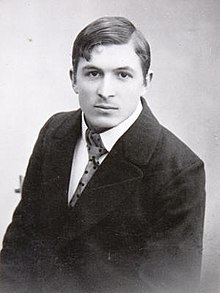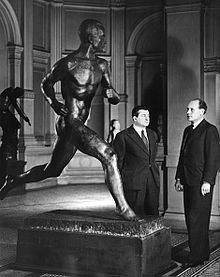Wäinö Aaltonen
Wäinö Aaltonen | |
|---|---|
 Aaltonen in the early 20th century | |
| Born | 8 March 1894 |
| Died | 30 May 1966 (aged 72) |
| Occupation | Sculptor |
| Years active | 1916–1961 |
| Notable work | Paavo Nurmi statue, 1925 Aleksis Kivi Memorial, 1939 Statues in the plenary chamber of Parliament House |
| Spouses | Aino Pietikäinen (m. 1920–19??) Elsa Rantalainen (m. 1931–19??) Elvi Hertell (m. 1942–19??) Elisabet Maasik (m. 1961–19??) |
Wäinö Valdemar Aaltonen (8 March 1894 – 30 May 1966) was a Finnish artist and sculptor.[2] The Chambers Biographical Dictionary describes him as "one of the leading Finnish sculptors".[3]
He was born to a tailor in the village of Karinainen, Finland. He became interested in art after being deaf as a child, and attended the School of Drawing of the Turku Art Association from age 16, or specifically between 1910 and 1915.[4] He had spent many of the early years at this school studying painting under Victor Westerholm,[5] but he was mainly self-taught as a sculptor. He learned the technics of treatment of marble with his relative Aarre Aaltonen, and by working as a trainee stonemason in Hirvensalo. Sculptor Felix Nylund was a substitute teacher in the art school in Turku for one season, and his work was inspiration for young Aaltonen.[6]
A journey Aaltonen made to Italy in 1923 opened his eyes to cubist and futurist art. These elements can primarily be seen in his paintings.
As the Republic of Finland arose, and the First World War raged, he sculpted War Memorials. He soon became a nationalist icon, the exemplar Finn, establishing an exhibition in Stockholm in 1927. His sculpture is nationalist in nature, and he is noted for monumental figures and busts portraying citizens of Finland. An example is the 1925 sculpture of Paavo Nurmi, a cast of which is exhibited outside the Helsinki stadium. Another notable work is that of Jean Sibelius, a bust of 1928. These two works, like the main body of his work, are bronze casts—though he did work in stone and even glass. Though chiefly naturalistic, the cubist influence is also present here. He was one of the early 20th-century pioneers of direct carving.
When the new House of Parliament for Finland was built, architect Johan Sigfrid Sirén wished he could buy sculptures directly from Aaltonen. Instead, an open competition was announced, and Aaltonen's Work and the Future was selected as the winner. The series of gilded plaster sculptures that Aaltonen completed in 1932 were cast in bronze after his death.[7]
Aaltonen was married four times. His first wife was singer Aino Alisa Pietikäinen from 1920, second wife actor Elsa Emilia Rantalainen from 1931, third wife gallerist in Galerie Artek Elvi Elisabet Hernell from 1942 and fourth wife medical doctor Marie Elisabeth Maasik from year 1961. His son Matti Aaltonen became an architect, who designed e.g. Wäinö Aaltonen museum in Turku.[6]
A large collection of his works are on permanent exhibition at the Wäinö Aaltonen Museum of Art in Turku.[8] His work was also part of the sculpture event in the art competition at the 1948 Summer Olympics.[9]
Works
[edit]

- Tytön pää, n. 1917
- Graniittipoika, 1917–1920
- Maria Jotuni, 1918–1920
- Opettajani, 1919
- Aaro Hellaakosken pronssipää, 1919
- Savonlinnan sankaripatsas, (The Hero's Grave) 1919–1921
- Punagraniittinen neito, 1923
- Mustagraniittinen neito, 1924
- Paavo Nurmi runner statue, 1924–1925
- Seisova nainen, 1920–1924
- Istuva nainen, 1920–1925
- Uimaan lähtevä nainen, 1924
- Turun Lilja, n. 1924–1926
- Musica, 1926
- Aleksis Kivi statue (Tampere), 1926–1927
- Statues on Hämeensilta bridge, Tampere: Eränkävijä (the Hunter), Veronkantaja (the Tax Collector), Kauppias (the Merchant) ja Suomen neito (the Maiden of Finland), 1927–1929
- Myrsky (Memorial statue for the 53 victims of the sunken Finnish torpedo boat S2 in Reposaari, Pori), 1930
- Statues in the plenary chamber of Parliament House 1930–1932
- Aleksis Kivi Memorial (Helsinki), 1930–1939
- Marjatta, 1934
- Delaware-muistomerkki, 1937–1938
- Vapauden jumalatar seppelöi nuoruuden, 1939–1940
- Memorial of the Battle of Kämärä, 1939/1949
- Tampereen Osuustoimintamuistomerkki, 1949–1950
- Ystävyys solmitaan (Joint monument for the cities of Turku and Gothenburg), n. 1948–1955
- Lahden sankaripatsas, 1952
- Rautatienrakentajien muistomerkki, 1957, Hyvinkää
- Genius ohjaa nuoruutta (in front of the University of Turku main library), 1958–1960
- Statues of presidents in front of Parliament house: K. J. Ståhlberg, 1957–1958; P. E. Svinhufvud, 1957–1959
- Genius Montanus (on Aaltonen's grave in Turku), 1960
- Johannes Gutenberg, 1962 (Büste)
References
[edit]- ^ a b "Wäinö Aaltonen". Olympedia. OLYMadMen. Retrieved 5 October 2022.
- ^ "AALTONEN, WÄINÖ Waldemar". Register of the Artists' Association of Finland (in Finnish). Artists' Association of Finland. Retrieved 15 January 2017.
- ^ Chambers Biographical Dictionary, ISBN 0-550-18022-2, page 1
- ^ Schildt, Göran, Modern Finnish Sculpture. Praeger Publishers, New York, 1970
- ^ Ekström, Kjell (2023). Ida, Anna and Elin: Three Members of the Önningeby Artists' Colony. Önningebymuseet, UAB BALTO print. ISBN 978-952-69688-5-8.
- ^ a b Ahtola-Moorhouse, Leena. "Aaltonen, Wäinö". Biografiskt lexikon för Finland (in Swedish). Svenska litteratursällskapet i Finland. Retrieved 15 January 2017.
- ^ "Parliament's Buildings and Art" (PDF). Parliament of Finland. Retrieved 15 January 2017.
p.21
- ^ "Wäinö Aaltonen". Wäinö Aaltonen Museum of Art. 24 April 2015. Retrieved 15 January 2017.
- ^ "Wäinö Aaltonen". Olympedia. Retrieved 27 August 2020.
External links
[edit]![]() Media related to Wäinö Aaltonen at Wikimedia Commons
Media related to Wäinö Aaltonen at Wikimedia Commons
- Wäinö Aaltonen Museum of Art in Turku (in Finnish)
- Art Signature Dictionary, genuine signature by the artist Wäinö Aaltonen Here are 11 examples of Wäinö Aaltonen's signature and monogram, six dated from 1925 to 1940.
| International | |
|---|---|
| National | |
| Artists | |
| People | |
| Other | |
Text is available under the CC BY-SA 4.0 license; additional terms may apply.
Images, videos and audio are available under their respective licenses.
